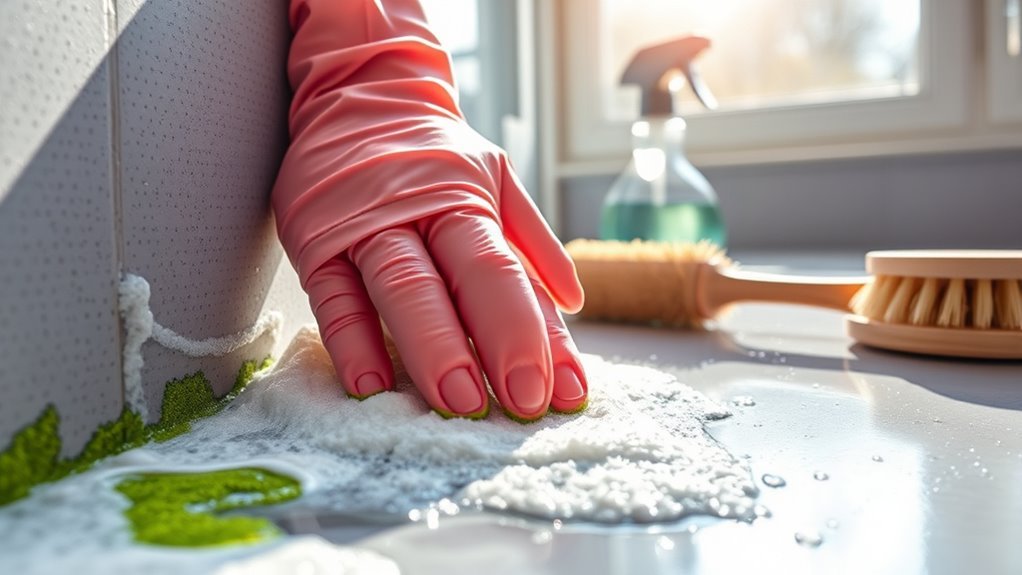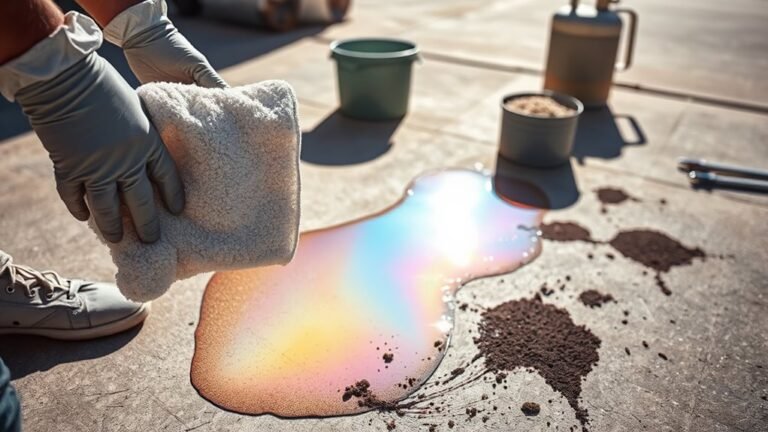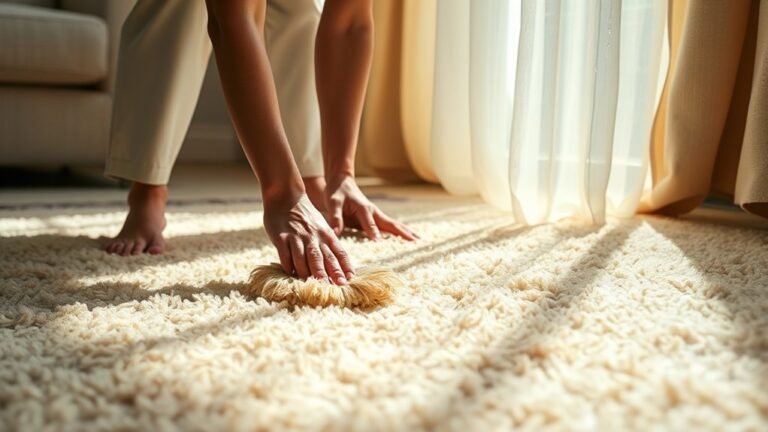Cleaning Techniques for Mold Owners
If you spot mold in your home, start by identifying its type—black, white, green, or others. Always wear gloves, goggles, and an N95 mask to protect yourself. Use a sturdy brush and a mold-killing spray like diluted bleach or vinegar to scrub affected surfaces. Ventilate the area well and dry it completely afterward. Control humidity and fix leaks to prevent mold from coming back. Keep going, and you’ll find helpful tips to keep your home mold-free for good.
Identifying Different Types of Mold

How can you tell which type of mold you’re dealing with? Spotting mold is your first step toward reclaiming control over your space. Mold types vary in color, texture, and where they thrive. Black mold often appears dark and slimy, while white mold looks powdery. Green mold can be fuzzy, and some molds even have a blue or yellow tint. Each mold type reacts differently to cleaning methods, so knowing what you’ve got matters. Pay attention to where the mold grows—bathrooms, basements, or around leaks. You’ll recognize mold by its musty smell and visible patches. By identifying mold types accurately, you gain the freedom to choose effective cleaning strategies and protect your home without unnecessary hassle. Spotting mold is your first step to freedom from its hold.
Essential Safety Measures for Mold Cleaning
Before you start cleaning mold, you’ll want to take key safety precautions to protect yourself and your home. First, gear up with proper protective gear—think gloves, goggles, and an N95 mask—to shield your skin, eyes, and lungs from harmful spores. Make sure your space is well-ventilated by opening windows or using fans to reduce airborne mold particles. Avoid spreading mold spores by sealing off the area with plastic sheeting if possible. When you finish, don’t just toss moldy materials in the trash; practice safe disposal by sealing contaminated items in heavy-duty plastic bags to prevent spores from escaping. Taking these steps lets you tackle mold confidently, keeping your freedom intact without risking your health or home environment.
Tools and Materials Needed for Effective Cleaning

Effective mold cleaning depends on having the right tools and materials on hand. To tackle mold removal efficiently, you’ll need essential cleaning supplies like gloves, a mask, and protective eyewear to keep yourself safe. Grab a sturdy brush or sponge for scrubbing surfaces without damaging them. A spray bottle filled with a mold-killing solution—such as diluted bleach or vinegar—will help you treat affected areas effectively. Don’t forget plastic bags for disposing of contaminated materials and a vacuum with a HEPA filter to capture mold spores. By being well-equipped, you maintain control over your environment and guarantee thorough cleaning. Your freedom to live mold-free starts by preparing smartly with the right tools and cleaning supplies.
Step-by-Step Cleaning Procedures for Surface Mold
Cleaning surface mold involves a few key steps that you can follow to restore your space safely and thoroughly. First, make sure you’re wearing protective gear like gloves and a mask. Next, ventilate the area to keep fresh air flowing. Then, gently scrub the affected surface with a mold removal solution, focusing on visible spots. Use a soft brush or cloth to avoid damaging the material. After scrubbing, rinse the surface with clean water and dry it completely to prevent mold’s return. If needed, apply a surface treatment that inhibits future growth. Remember to dispose of cleaning materials properly and wash your hands afterward. Following these steps gives you control over mold removal, helping you reclaim your space with confidence and freedom.
Preventative Strategies to Minimize Mold Growth

Once you’ve tackled surface mold, the next step is to focus on keeping it from coming back. Preventative maintenance is key to preserving your freedom from mold’s grip. Start by controlling humidity—keep indoor levels below 60% to stop mold spores from thriving. Regularly inspect damp areas and fix leaks promptly. Good airflow also discourages mold growth.
| Strategy | Action |
|---|---|
| Humidity Control | Use dehumidifiers, ventilate |
| Regular Inspections | Check basements, bathrooms |
| Quick Repairs | Fix leaks, seal cracks promptly |
Frequently Asked Questions
Can Mold Cause Allergic Reactions or Health Issues?
Yes, mold can definitely cause allergic reactions and health effects that impact your well-being. You might notice mold symptoms like sneezing, coughing, itchy eyes, or skin rashes. If you’re sensitive, exposure could lead to more serious issues like respiratory problems or asthma flare-ups. It’s important to recognize these symptoms early so you can protect your health and enjoy the freedom of a safe, mold-free environment.
How Quickly Does Mold Spread in Humid Environments?
Did you know mold growth can double in size every 24 to 48 hours in humid conditions? When humidity levels stay above 60%, mold spreads rapidly, making your space uncomfortable and unhealthy. You’ve got to stay on top of moisture to keep mold at bay. By controlling humidity, you reclaim your freedom from mold’s quick takeover, ensuring your home stays fresh and safe without constant worry.
Are There Natural Alternatives to Chemical Mold Cleaners?
Absolutely, you can ditch harsh chemicals by using natural alternatives like vinegar solutions and baking soda. Vinegar’s acidity helps break down mold, while baking soda’s gentle scrubbing action removes it and absorbs moisture. You simply spray vinegar on the moldy area, let it sit, then scrub with a baking soda paste. This way, you maintain a cleaner space without compromising your freedom to choose safer, eco-friendly options.
What Is the Difference Between Mold and Mildew?
Ever wondered how mold and mildew differ? You’ll notice mold characteristics include fuzzy or slimy growths, often in various colors, thriving in damp, dark places. Mildew types, on the other hand, usually appear as flat, powdery patches, mostly white or gray, on surfaces like leaves or bathroom walls. Understanding these differences helps you take control, choosing the right approach to keep your space fresh and free from unwanted growth.
How Does Humidity Control Affect Mold Growth Indoors?
You’ll want to keep humidity levels below 60% because mold thrives in moist environments. When indoor ventilation is poor, moisture builds up, creating the perfect conditions for mold to grow. By improving airflow and controlling humidity, you’re fundamentally setting boundaries for mold’s freedom to spread. So, managing these factors gives you control over your space, helping you live mold-free without feeling confined or restricted.






